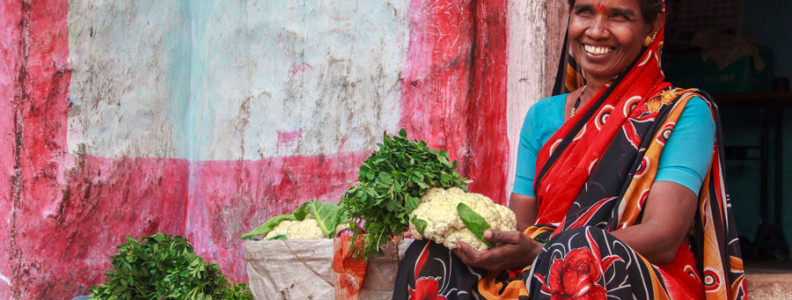In my great grandmother’s house in Thanjavur, a small town in Tamil Nadu, every meal represented an elaborate ritual. Each night, she washed a fresh set of clothes for the next morning (always a colorful nine yards sari and its blouse) and hung them atop the highest clothing line on the balcony, to prevent anyone from inadvertently dirtying them. The following morning, she rose at 4:00 AM, while the rest of the house still slumbered, and took a bath to cleanse before cooking. Prior to touching any ingredients, she prayed, sitting in the main hall beside a faded wall covered with frame after frame of Hindu iconography. Only then would she start to prepare the meal.
When we sat down to eat, in a cross-legged row on the floor across from the prayer wall, the meal itself was systematic. First, someone laid plantain leaves, used as (biodegradable!) plates in rural South India, on the cleaned floor. Then, the men recited Sanskrit prayers, pouring a little water into their right palms and circling their palm leaves with it to signify cleansing the mind and heart before approaching the food. Somebody took a little food and left it outside for the crows — a ritual called “kaka shadham”, or “crows’ rice”, in Tamil, to return part of the food to nature. Normally, I was designated as the crow feeder.
After all this, the meal would commence with a clatter of sounds, colors, textures, and tastes. We ate deftly, using our right hands to gracefully sweep food across the plantain leaf into our mouths. When the last morsel disappeared, several family members would say aloud “Annadatha Sukibhava,” an old Sankrit saying meaning “May the ones providing this food be happy and healthy.” The customs, and the food, contributed to a celebration of community and utter deliciousness.
Today, I try to think of my food in this context. I love how truly delicious food can engage all five senses at once. Ripe, bright vegetables, their lush skins just begging to be chopped. The smell of spices — cumin, turmeric, saffron, coriander, mint — dancing lightly across the air. The inquisitive tang of my grandmother’s freshly churned butter. Crispy, warm pain au chocolate, or the sweet, slightly acidic tenor of fresh mango sorbet.
I could play with adjectives to describe food for hours. In fact, I’ve developed this skill as a mental hobby over the years when confronting boredom. Instead of suffering through an especially apathetic meeting on retirement options, I take refuge in quietly devising fragrant soups, towering sandwiches and mountain ranges of ice cream topped with Maraschino cherries. I confess: I love to eat. There’s a reason why Pixar’s “Ratatouille” is my favorite film.
For me, eating is not just about sating a hungry stomach. It’s about taking the time to prepare a varied meal and presenting it in an aesthetically pleasing way. I always eat sitting down, and try to eat unhurriedly, really tasting each bite. It’s a way to ground myself in the evenings after work: a near-meditative experience. After a long day, I’m eager to come home, kick off my shoes, and dedicate evenings to achieving deliciousness.
Food wasn’t always such a spiritual experience for me. As a child, I ate to live — a finicky eater in a very food-oriented Indian American family. I resorted to craftily concocting various ruses, like spreading leftovers around my plate to make it look sparser, gathering food in a corner of the plate to rest invisibly under my hand, and shifting food onto my father’s plate when he wasn’t looking.
Hindu culture has an extensive culinary theology that ascribes ritual and mystical importance to food. Food is a manifestation of Brahman, the supreme energy motivating the universe. “Food is God,” my mother would tell me, as I pushed curry moodily around my plate as a child. At the time, I couldn’t relate: eating quickly was a ticket to getting outside.
Although I didn’t revel in food, I always loved the rituals. They made meals more interesting for a child who would rather be playing with friends on the block. Though we lived in America, my mother still sent me outside to leave a little rice in the backyard for the crows.
Hindu scriptures point to three forces that influence food’s nutrition: pathra shuddhi, the cleanliness of the cooking vessels, paka shuddhi, the chef’s cleanliness and mental attitude, and pachaka shuddhi, the quality of ingredients. Because “you are what you eat,” Hindus believe that these three shuddhis, or purities, directly transfer to the eater.
Hindu traditions also place importance on the eater’s experience. A Sanskrit saying from the Taittreya Upanishad — “Annam Brahmeti Vyajanat” — summarizes several scriptures on the topic. A mystic, meditating on his food, notices a subtle life force permeating the entire cosmos.
The practical message? Eat like it’s your last meal, and be thoroughly aware of every bite. In Hindu culture, eating is a ritual: a sacrifice to the Supreme, unified by the recognition that process (cooking), object (food), and individual are all inextricably connected.
Eventually, once I left home, I learned to appreciate good food a lot more. Coming across scrumptious vegetarian food in cafeterias was rare: the food tended to be boiled until it died. I became a real foodie when I started cooking for myself. Today, creating a new dish after a long workday, I feel a connection to my (now deceased) great grandmother, who also viewed cooking as a daily ritual.
I’ve noticed that we tend to collectively push the seemingly mundane tasks that are critical to survival, like eating, into the background. For many, food is a steady, often mechanized habit. Yet, it has a depth that cannot be ignored. The next time you see something yummy, turn it into your own ritual: sit down, dig in, and enjoy every bite.

